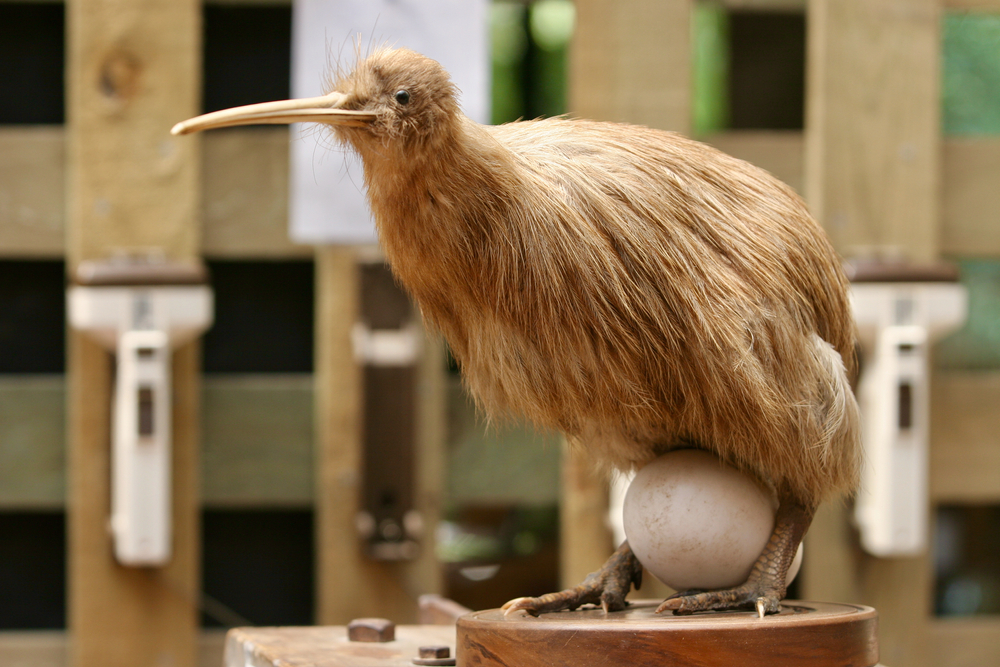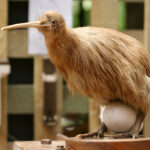Can Kiwi Birds Swim? Kiwi birds are fascinating creatures that are native to New Zealand. These flightless birds have a unique appearance and are known for their tiny wings and long beaks. If you’re curious whether kiwi birds can swim, you’ve come to the right place.
The answer to whether kiwi birds can swim is no, they cannot. While some flightless birds, such as penguins, are excellent swimmers, kiwi birds are not adapted for swimming. Instead, they are adapted for life on land and use their strong legs to navigate their forest habitats. Kiwi birds are also nocturnal, which means they are most active at night and spend their days resting in burrows.
Kiwi Birds: An Overview

If you want to know about the unique and fascinating bird species, then Kiwi Birds are worth exploring. Kiwi Birds are flightless birds that are found only in New Zealand. They are nocturnal creatures, meaning they are active at night and rest during the day.
Kiwi Birds are known for their distinctive physical features, which include long legs, sharp claws, and a long beak with nostrils at the end. They have brown feathers that are hair-like in structure. Kiwi Birds are unique in their behavior and structure and are classified as ratites, which means they do not have a keel on their sternum like other birds.
There are five species of Kiwi Birds, including the North Island Brown Kiwi, Little Spotted Kiwi, Great Spotted Kiwi, Okarito Kiwi, and Southern Brown Kiwi. The North Island Brown Kiwi is the most common species found in the North Island of New Zealand. The Great Spotted Kiwi is the largest species and is found in the South Island of New Zealand.
Kiwi Birds are facing threats due to deforestation and habitat destruction. However, conservation efforts are being made to protect these unique creatures. Kapiti Island, Okarito Kiwi Sanctuary, and Rowi Sanctuary are some protected areas where Kiwi Birds are conserved.
In conclusion, Kiwi Birds are fascinating creatures that are worth exploring. Their unique physical features and behavior make them stand out from other bird species. However, their survival is under threat due to deforestation and habitat destruction. Conservation efforts are necessary to protect these unique creatures for future generations to enjoy.
Habitat and Predators
Kiwi birds are native to New Zealand and are found in various habitats throughout the country, including forests, scrublands, grasslands, and farmlands. They are also found on several islands around New Zealand, including Stewart Island/Rakiura.
Kiwi birds are primarily ground-dwelling birds and do not fly, but they are excellent runners and can run up to 30 km/h speeds. They can also swim across rivers and small bodies of water, but they are not strong swimmers and avoid swimming whenever possible.
Kiwi birds have several predators, including stoats, ferrets, cats, and dogs, which are introduced predators to New Zealand. These predators pose a significant threat to kiwi birds, especially during their early life stages. Several conservation programs have been implemented across New Zealand to protect kiwi birds from predators, including predator control, habitat restoration, and captive breeding programs.
Overall, kiwi birds are adapted to a wide range of habitats in New Zealand, but introduced predators threaten their survival. Conservation efforts are crucial to ensure the survival of these unique and iconic birds.
Diet and Prey
Kiwi birds have a unique diet that consists of a variety of prey. They are omnivores, which means they eat both plants and animals. Kiwis mainly feed on insects, grubs, worms, and other invertebrates that they find on the forest floor. They use their long beak to probe the soil and dig out their prey.
Insects make up a significant portion of the kiwi’s diet. They are a good source of protein and are abundant in New Zealand’s forests. Kiwis also eat grubs, which are the larvae of beetles and other insects. Grubs are high in fat and provide the kiwi with the energy it needs to survive.
Worms are another important part of the kiwi’s diet. They are easy to catch and are a good source of nutrition. Kiwis use their sense of smell to locate worms in the soil and then use their beak to dig them out.
In addition to insects, grubs, and worms, kiwis also eat fruit and seeds. They are known to eat berries, figs, and other fruits that are found in the forest.
Overall, the kiwi’s diet is diverse and provides them with the nutrients they need to survive. They are adapted to their environment and have developed unique ways of finding and catching their prey.
Aquatic Abilities of Kiwi Birds
Kiwi birds are known for their unique characteristics, including their ability to swim. While they are flightless birds, they have strong legs and are excellent runners. In addition, they are also strong swimmers and can cross rivers when necessary.
Kiwi birds have been observed swimming across large rivers, using their buoyant bodies and strong legs. They can float and swim with ease, making them strong swimmers. While they are not aquatic animals, they can swim when needed.
It is important to note that not all kiwi birds are strong swimmers. Some may not be as comfortable in the water as others, and their swimming abilities may vary. However, in general, kiwi birds are known to be strong swimmers.
In summary, kiwi birds can swim and are strong swimmers when needed. While they are not aquatic animals, they can cross rivers and swim when necessary. Their buoyant bodies and strong legs allow them to float and swim easily.
Comparison to Other Birds
Regarding swimming, kiwi birds are unique compared to other birds. As flightless birds, kiwis have adapted to life on the ground, and swimming is not an everyday activity. However, other birds like ducks, petrels, and penguins, are quite comfortable in the water. Here’s a comparison of kiwis to other birds in terms of their swimming abilities:
- Ducks: Ducks are excellent swimmers, and their webbed feet help them easily paddle through the water. On the other hand, Kiwis have long, thin legs that are not well-suited for swimming. While they can swim if necessary, it is not an everyday activity for them.
- Petrels: Petrels are seabirds that fly over the ocean most of their lives. They are also capable swimmers, using their wings to propel themselves through the water. Kiwis, however, do not have the same adaptations for swimming, and their wings are not well-suited for aquatic propulsion.
- Penguins: Penguins are perhaps the most famous swimming birds and are highly adapted to life in the water. They use their wings to “fly” through the water, and their streamlined bodies and webbed feet make them excellent swimmers. Kiwis, however, are not as well-adapted to swimming, and their wings are not designed for aquatic propulsion.
- Ostriches and Cassowaries: Ostriches and cassowaries are both flightless birds, like kiwis, but they are not adapted to swimming. They have long, powerful legs that are well-suited for running on land, but not for paddling through water.
While kiwis are not well-suited for swimming compared to other aquatic birds, they are still fascinating creatures with unique adaptations for life on the ground.
Adaptations and Evolution
Kiwi birds are flightless and have evolved to have several unique adaptations to survive in their native habitat. These adaptations have helped them thrive in their environment without flying.
One of the most significant adaptations of kiwi birds is their ability to run quickly. They have powerful legs that allow them to move through the forest floor easily. Their stout legs also help them to balance and navigate through rough terrain.
Kiwi birds have also evolved to have hair-like feathers that help them to blend with the undergrowth in the forest. This adaptation helps them to avoid detection by predators who rely on sight to hunt their prey. Additionally, kiwi birds have whiskers at the base of their beak that aid in nocturnal navigation and nostrils at the end of their beak that assist them in finding food.
Interestingly, kiwi birds do not see in color but have a highly developed sense of smell. This adaptation is helpful for a bird that feeds at night. Their changes in vision and smell are similar to adaptations found in nocturnal mammals.
Overall, kiwi birds have evolved to be well-adapted to their environment without the need to fly. Their unique adaptations have helped them to survive and thrive in their native habitat.
For More Info : https://www.audubon.org/
Can kiwi birds float?

While it’s not common for kiwi birds to be in the water, they can float if necessary. If a kiwi bird finds itself in the water, it can manage to keep afloat, likely due to the air pockets between their feathers and body, which can provide some buoyancy. However, it’s important to note that swimming and floating are not natural behaviors for kiwi birds and are generally avoided. They are adapted for a terrestrial lifestyle and are much more comfortable on land.
Can kiwi birds fly?
No, kiwi birds cannot fly. They are part of a group of ratites, including other flightless birds like emus, ostriches, and cassowaries. Kiwis have tiny wings hidden within their thick, hair-like feathers, but they aren’t large enough or strong enough to lift their relatively heavy bodies into the air.
Instead, they are well-adapted to life on the ground. They have a keen sense of smell, which is unusual for birds, and they use this to find food in the undergrowth. They also have strong legs, which they use for walking, running, and digging burrows.
Can Kiwi Birds climb trees?
Kiwi birds are not known for climbing trees. Their physical adaptations – strong, muscular legs and long beaks – are geared towards a ground-dwelling lifestyle. They are excellent at digging burrows and walking or running on the ground but lack the necessary body structure to climb trees effectively.
Kiwi birds generally spend their lives on the forest floor and in burrows. They use their keen sense of smell to find small invertebrates, seeds, grubs, and worms to eat, and their strong legs to run swiftly when threatened. Kiwis are also nocturnal, sleeping most of their day in their burrows and coming out to feed at night.